L'Avventura, 1960, directed by Michelangelo Antonioni, screenplay by Michelangelo Antonioni, Elio Bartolini, and Tonino Guerra, story by Michelangelo Antonioni.
Film genres have observable lifecycles. Comedy has survived pretty much unchanged since L'Arroseur Arrosé, like those bacteria that have been alive since before the dinosaurs. Westerns are more like cicadas: they burrow underground for ten years or so, and just when you've forgotten they exist, they're suddenly everywhere. And then there are the mayflies: distinct genres that show up for a few years, have their moment, and end up smeared all over the windshield of history.
L'Avventura is the preeminent example of one of those windshield smears, where you'll also find Last Year at Marienbad, La Dolce Vita, and most of Antonioni's other films. They all share a sort of apocalyptic, exhausted ennui and feature characters who are miserable, wealthy, dissolute, and incredibly well-dressed. Their genre didn't stick around long enough to get an official name, but Pauline Kael called them "The Come-Dressed-As-the-Sick-Soul-of-Europe Parties," and that's good enough for me. They moved from groundbreaking to cliché to parody in record time: Kael was hailing L'Avventura in 1960 and condemning everything that followed by 1961. She and Andrew Sarris didn't agree on much, but they agreed on this: Sarris coined the term "Antoniennui." But no film can be held responsible for the worst excesses of its genre, and L'Avventura is truly a remarkable, unique achievement, innovative in narrative structure, visual grammar, and editing. And frame for frame, it's one of the most beautiful movies you'll ever see.
The film begins with a tracking shot of Anna, a sourfaced young woman played by Lea Massari, walking toward the camera, away from a villa. We hear her father lamenting the new construction smothering his villa, and then Antonioni cuts to a very long take of Massari and Renzo Ricci having an argument. The shot lasts 54 seconds, and the camera moves as they cross each other, but here's the most striking framing:
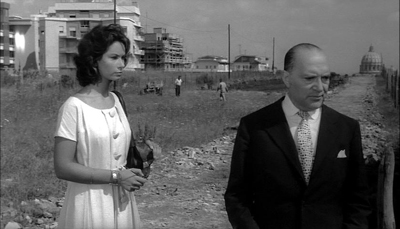
There's Antonioni in a nutshell: two people talking past each other without eye contact, meticulously staged and photographed. Notice how he's put Massari in front of the modern architecture her father was complaining about, while putting the older man on that great diagonal line toward St. Peter's: do you think one of these two characters is meant to represent modernity encroaching on the old order of things? Imagine you are the location scout asked to find a spot from which there is a straight, unpaved road that leads directly toward the basilica, with new apartments under construction to the left, and nothing else of visual interest nearby, and you'll have some idea of the rigid control of mise-en-scène that is typical of the film.
Actually, that shot encapsulates the other signature elements of Antonioni's style: a 55-second take is an eternity in film time, but this isn't a Welles-style showpiece; Antonioni just lets takes run for much longer than most directors. Also in that shot is his biggest narrative innovation: the character of Anna—of which more later. For now, the important thing is that she and her friend Claudia are about to embark on a yacht trip. Claudia, played by Monica Vitti, is at least a little more cheerful than Anna:
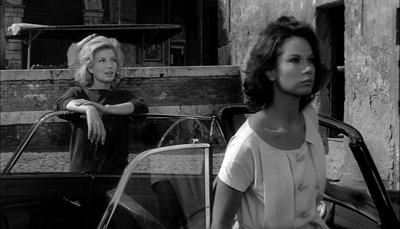
They're to be accompanied on the trip by Anna's boyfriend, a vainglorious architect named Sandro. He's the kind of guy who, when Anna turns to look at him, responds by saying "Should I give you my profile?"

Sandro inspires nothing but contempt and boredom in Anna; his great gift is that he's clueless enough not to notice. As one might expect from people with that level of world-class selfishness, they celebrate their reunion by having sex while Anna waits for them outside with the car.

They're perfect for each other. As Antonioni cuts back and forth between Sandro and Anna upstairs and Claudia below—left to her own devices, Claudia wanders through an art gallery, and we get the sense that she isn't quite as far gone as her friends.
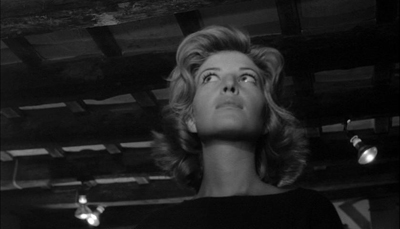
The boat trip is basically as masturbatory as Anna's relationship with Sandro: shallow people with too much money attempting to divert themselves. In a sense, Sandro is the happiest of the lot, simply because he's too stupid to take anything seriously. Anna tells him that she wants to end things and all he can do is laugh it off.

Shortly after their conversation, Anna disappears entirely, and for a moment, we feel like we might be in a different kind of film, a mystery. There's no sign of her, and the only clue is the sound of what might have been a boat shortly before the lady vanishes.
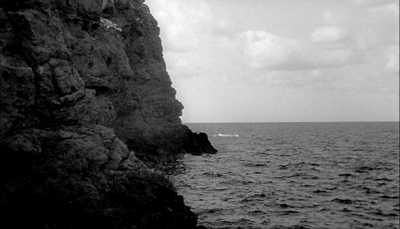
Her friends perform a perfunctory search of the island, but you can tell their hearts aren't really in it. In a film that introduced the world to Antonioni's visual vocabulary, this is one of the shots were you can see how easily his style could slide into self-parody:
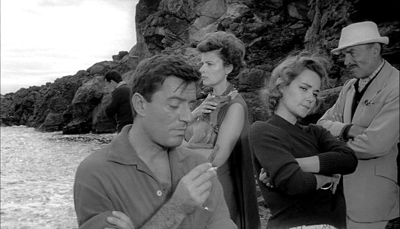
Only Claudia seems to really care what’s become of her friend. We’ve seen this movie before: the lost girl, the sparring aristocrats, the mysterious indifference. Claudia will eventually overcome the bureaucratic inertia of the Italian police department, discover that Anna’s friends know more than they are telling, and, in the end will discover the truth, standing as a woman alone against insurmountable odds. Right?

Well, not exactly. Claudia does take a solo trip to each of the nearby islands to see if there's any sign of Anna, and as in any film of this sort, there are tantalizing clues: the police investigation finds some smugglers who were in the area who seem to know more than they are telling.
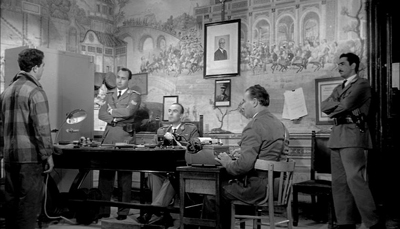
But we don't accompany her on her tour of the islands, and the entire search turns out to be a false lead. Claudia cares less and less about finding her, and Sandro never really cares at all: within 24 hours he's coming on to Claudia.

Creepy. Claudia, for her part, pretty quickly gets over her reservations about sleeping with her vanished friend's boyfriend.
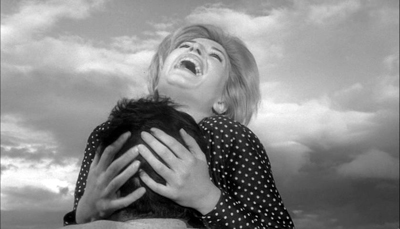
There is a moment when Claudia believes Sandro has found Anna, and has to confront her feelings about this (fear and shame), but that's the last we hear of her. The narrative winds down as the various characters lose interest in Anna's fate. Like Waiting for Godot, L'Avventura is mostly about passing the time. Sandro, an artist manqué, once wanted to be an architect, but now does cost analyses and consoles himself by knocking bottles of ink over on younger artist's sketches.
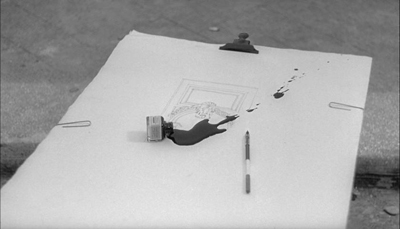
This is where the film starts to show its age: imagine making a film about the idle rich today, and making the idlest, most vapid character be an architect. Even the closest thing the film has to Paris Hilton is nominally some sort of writer. Antonioni couldn't have known it at the time, but the celebrity-industrial-complex was just getting ready to spit out things that were way uglier than the apartment buildings encroaching on Rome.
In fact, as awful as he's supposed to be, I like Sandro: I know that Claudia is the emotional center of the film, but Sandro's pettiness and insecurity is carefully observed and seems human. Films like L'Avventura are always just a single drawn-out philosophical conversation away from drifting away into the abstract, and Claudia serves as too much of an audience surrogate to really ground the film. This is not to say that she doesn't surprise from time to time, as when she makes faces at herself in the mirror:

For the most part, however, Claudia's role in the film is to be fluid and malleable; even her face-making revolves around trying on different identities. She toys with becoming Anna, borrowing her shirt, her fiancé, and even her hair.
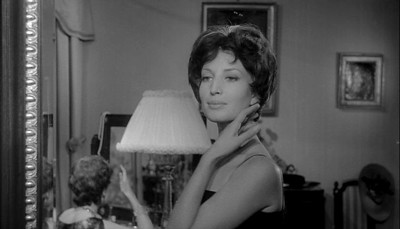
Lynch must have seen this at a formative age. The difference between 1960 and 2001 is that in 1960, Antonioni still believes that there was an age of authenticity within recent memory. It produced the classical architecture that Sandro is always photographed in front of, and the ruins that appear in L'Avventura's final images.

By the time Lynch makes Mulholland Dr., the only relic from the golden age is the image of one Margarita Carmen Cansino, post-electrolysis, post-dye-job, post-retouching. The tagline gives the game away:

No, there never was. I personally don't believe in golden ages. Some disastrous things may have happened to our culture in the twentieth century, but I think that the last generation with any claim to authenticity were primates. This isn't a new argument, either: Antonioni isn't saying anything in L'Avventura that you won't find in Ecclesiastes. So what matters is execution. L'Avventura is not an entertaining film (how could it be?), but its photography is a frame-by-frame refutation of any argument Antonioni could make about the death of culture. Maybe all he saw to do was catalog wreckage. But what wreckage, and what a catalog.
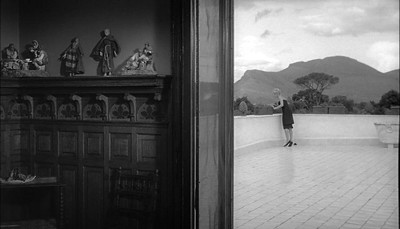
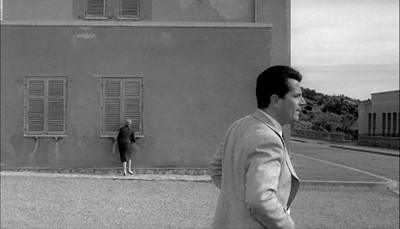


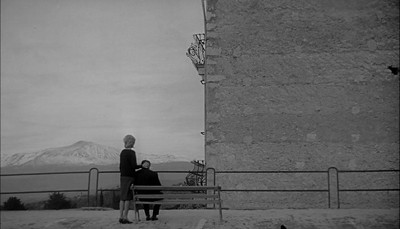
Randoms
- There's a wonderful DVD extra of Jack Nicholson reading an essay about how little regard Antonioni had for actors. Like, for example, Jack Nicholson, star of Antonioni's The Passenger. This is followed by a reminiscence in which Nicholson talks about how he didn't get the impression that Antonioni had very little regard for Jack Nicholson, star of The Passenger.


28 comments:
Great essay, especially the closing. Love the Lynch tie-in too.
However, at the risk of sounding like a high school English teacher, I'm confused by your random note - was Jack Nicholson's impression that Antonioni DID have a high opinion of him in The Passenger and thus the essay is wrong, or did Antonioni, true to the essay's conceit, have little regard for Jack Nicholson?
Sorry to be thick.
Like Psycho, which also came out in 1960, this film subverts our expectations of how a narrative is supposed to unfold, as everyone in the movie seems to forget that it's about the mystery of Anna's disappearance. If you've read enough about the film to get you interested in viewing it(probably including the back of the DVD case), the fact that this happens has probably been spoiled for you. As I watched this, I tried very hard to imagine what it must have been like for someone who had no idea of what to expect. I'm sure it was either exhilarating or exasperating (or both), but it didn't get many neutral reactions (recall that it was booed at Cannes). Think of the anger of many at the inconclusive ending of No Country for Old Men and consider that L'avventura's inconclusive ending encompasses its entire second half.
Your images do a good job of showing why I love this film so much. It's just so beautiful to look at (could you imagine colorizing it?), that almost nothing else matters. The film also sports one of the best Criterion commentaries I've heard yet, and a listen is well worth the time.
Excellent write up and great still shots. Makes me want to go watch it again.
Did you get a chance to watch this with the supplied commentary track? Gene Youngblood discusses in it how Antonioni used architectural pieces like arches, gates, and doorways as "portals" to imply character change, and it's pretty consistent throughout the film. Any time someone is about to have a shift in character, they physically pass under or through something.
Sometimes you depress me, Matt. Because I'll be all happy, and doing what I'm doing, and then read this, and read this: "Maybe all he saw to do was catalog wreckage. But what wreckage, and what a catalog."
And wonder... There's a good chance I'll never write anything that good
But as I was saying: great stuff. (I LOVED the National Review Cruise link--"wait, they have cruise?")
If you're still interested in Antonioni (and I like him very much, albeit more on mute), I'd actually recommend the other two of his "trilogy": La Notte and L'Eclisse. The latter is stronger than the former, but they both have less of the semi-pretentious bullshit in L'Avventura, and they up Antonioni's visual style without compromising on presences. I myself prefer L'Eclisse because I like Alain Delon, but it's also briefer and more stylistic (read: there's less "content" for Antonioni to preach).
For whatever reason I wasn't crazy about L'Avventura when I watched it. Normally I can willingly sacrifice entertainment value for artistic value, but Antonioni's genius didn't really hit me until the final shot, at which point I realized I needed to re-watch it (still haven't done so unfortunately). I also much prefer L'Eclisse, which is a top-ten film of mine, seriously one of the most perfectly shot movies I've ever seen that communicates Antonioni's modernist fatigue far better than L'Avventura does.
A not actually funny story that seems to fit into Antonioni's encroachment of modernity. I only first saw this movie a year or so ago and I was expecting this very tough formal style considering his reputation, you should read Bergman's comments. But as I watched it I thought the style was down right Hollywood and didn't notice much of the extraordinary things in his camera work. The only reason for this I can figure is that his style has now become the old and for a generation raised on Tarr, Akerman, and van Sant his modern style has been ruined by the even more modern sons.
JJ sez: Yeah, Lynch was clearly influenced by it, but I'd argue Antonioni's deepest influence was on Micheal Mann. Who combined his modernist visuals and sense of urban alienation with slam-bam, hard-boiled noir characters and dialouge, and huge kinetic action setpieces--to great artistic dividend.
And I suspect Gordon Willis watched a few Antonioni films too before his glory years as a cinematographer...
Anonymous,
My impression was that you are right on both counts: Nicholson's impression while working with him was that Antonioni had a high opinion of him, but in fact, at least judging from the way he wrote about actors in the essay, Antonioni did not.
Mark,
Yes, I liked the commentary as well--and the Psycho comparison is apt, in that I can't imagine what it would have been like to watch the film with no expectations. Or with the wrong expectations, since judging from the trailer, this was marketed in the U.S. as something along the lines of ...And God Created Woman, just another European sex romp.
Cub Pup,
I did watch the commentary, and found it pretty insightful. I'll admit that I didn't pay too much attention to the discussion of portals, because it seems like many commentary tracks for many films point that out (I Know Where I'm Going! certainly does). It makes sense that Antonioni would have used that trope more systematically and meticulously than other directors, though.
Mathias,
Thanks, man, glad you liked it. I think the next National Review Cruise should go from Cyprus to Gaza City.
Stuart,
L'Avventura bears rewatching but it's pretty stubborn in its refusal to entertain.
Legato,
The deep focus in L'Avventura is crazy good and underrated, I think.
Anonymous,
I wouldn't have made the Michael Mann connection, mostly because the thought of Antonioni shooting an action sequence is completely unbelievable. Are there visual elements in Mann you'd point to as being particularly Antonioni-like, or a specific film you're thinking of?
JJ: Sure, well, it first occurred to me watching while watching ZABRISKIE POINT and THE PASSENGER. (which DO have explosions, shootings and sort of a car chase! :) Seriously, the images of Californian urban sprawl and the LAPD struck me as similar to HEAT, COLLATERAL, THE INSIDER....
As far as visual elements, the way Mann photographs modern cities in MANHUNTER, THIEF, HEAT, THE INSIDER, all struck me as very inspired by Antonioni's work, isolating individuals against huge, oppressive, empty, modernist backdrops (often at night, often lit by streetlights or flourescent light....) Also, the general alienation of many of his characters--great at their work, unable to connect with other people--strikes me as building upon the themes Antonioni explored as well.
But, I mean, I think Antonioni was the 20th century artist who really established certain concepts in the public conciousness; that big cities and modern technology were dehumanizing people and we were all isolated under skyscrapers and streetlights. He wasn't the first one, (Alan Ginsberg and HOWL preceded him, for instance) but his films were how the general public really picked up on those ideas. And if you accept that, then you can trace his influences to almost everywhere--to KLUTE, to ALL THE PRESIDENT'S MEN, SEVEN, FIGHT CLUB, half the action movies of the 70s and 80s (at least in terms of photography), even KOYAANISQUATSI...(which I suspect also influenced Mann).
One of the best quotes I've seen in the last couple of years went something like this: 'Antonioni is the difference between Bridge on the River Kwai and Lawrence of Arabia, between Spartacus and 2001, between Breathless and Contempt.' So, I agree with the idea that Antonioni's influence on other filmmakers has probably been more important than his individual films themselves.
On the other hand, while I can see the argument for Michael Mann as an Antonioni successor, I can also see the downside of that lineage in films like Miami Vice and Public Enemies, which I thought were both interesting failures.
I don't get your Lynch comparison. Are you saying , with MD, Lynch also is making a point about a lost golden age? Its not clear. Im not the sharpest knife in the drawer, so the Gilda poster doesnt help. Your text implies where it should explain your point. Maybe im not getting it because I still don't understand MD. It's one of my favorite films, but I have loved it without taking the effort to analyze it.
I saw L'Avventura back in the 80's when I was in high school and it flew over my head. I had seen almost all of hitchcock's films by then and was bored. The film left my head ringing with foley footsteps.
I loved your phrase "celebrity-industrial-complex" and am going to use it. Actually, this entry was extremely witty. And I laughed out loud at your use of some of the shots. Thank you! --shawn
Jeffrey,
That's a great quote. Better to spawn interesting failures than dull successes, I think.
Shawn,
Mullholland Dr. evokes L'Avventura in the scene where Betty remakes Rita to look like her; compare the shot of Claudia trying on the dark-haired wig (part of a progression—she tries on her friend's shirt, tries on her boyfriend, &c.) with this. I believe that the scene where Betty shows "Rita" her new hair in the mirror more or less explicitly quotes a shot of Anna and Claudia changing clothes on the boat, early in L'Avventura. More broadly (and this is more true of Mulholland Dr. than L'Avventura) both movies are about women constructing or redefining their identities. In Lynch's case, those identities are explicitly fictional: "Betty" in the first half of the film is a construction of the real Diane from the second half; "Rita" is a construction of Laura Harring's character in the first half. But "Rita Hayworth" was also a fiction (and "There NEVER was a woman like Gilda!") and so on down the rabbit hole. Is basically what I meant.
La Dolce Vita- Federico Fellini, whose films are anything but a windshield smear
If Mann did pick up ideas from Antonioni, he used them rather superficially. The point of Mann's films is not alienation or estragement, even if they are themes in the background.
I'd say a guy like Bela Tarr is very influenced by Antonioni, but he is more sentimental. That sentiment, combined with long shots, probably comes from Tarkovsky.
Theo Angelopoulos is another master of the long shot, and a few of his movies were definitely influenced by Red Desert.
I'd argue Red Desert was Antonioni's greatest visual achievement. Just think of how many directors went and painted walls/corridors/rails to heighten the sense of reality.
Actually, truth be told, younger directors probably got the last idea i mentioned from the French new wave, but even still, Red Desert is an expressionist masterpiece.
As for Gus Van Sant, he is not on Antonioni's level. No American art film director is in my view. They tend to imitate the style but they are light on content, and even the style isn't as complex or refined.
i like Van Sant, but he is no Bela Tarr, that's for sure, who i'd argue is the only real successor of the old guard.
After reading your entire blog, this felt like a good space to wonder.
How on earth will you ever finish such a heroic task? I'm rooting for you, but Criterion is still producing DVDs. The list is getting longer!
Regarding L'Avventura, I might want to see it, but then again, I might not. It just seems like a dead genre of the past, and I'm not sure I would understand it. After all, it was a cliche within one year of release. Whereas we are still - still! - talking about John Ford some 54 years after "The Searchers."
BTW - try checking out my blog. There's a writing contest on there and it would be great if I could see something.
Great essay on the camera techniques.
But the character analysis misses by miles (specially Claudia and Sandro). Least you should be open to ambiguities in the camera narations like these.
Sid,
Could you be more specific? What's your take on these characters?
Antonioni's films for me are like a voyeuristic experience; vicariously living through characters' experiences. I agree with an earlier comment about L'Avventura being more like a Hollywood version of an Antonioni work, but I find it to have an interesting balance of the existential formality of L'Ecclise and a more structured plot development of "Hollywood" type construction.
I still prefer L'Ecclise and La Notte over L'Avventura (in the supposed series of communication breakdown so to speak), but it has a uniqueness that breaks apart from the other two.
You make two points--one about the relationship between Lea Masari and the actor playing her father and their relationships to surrounding architecture, and one about the tableau of several actors on the island that approaches self-parody--that Youngblood in his commentary also makes. Even if you arrived at your observations independently, it would behoove you to acknowledge his prior comments.
Otherwise, great post.
Anonymous,
It's been a while since I wrote this and I don't remember the commentary well, but it's entirely possible that I didn't credit Youngblood and should have. I'll revise.
Hey man, great post. Keep writing.
Post a Comment